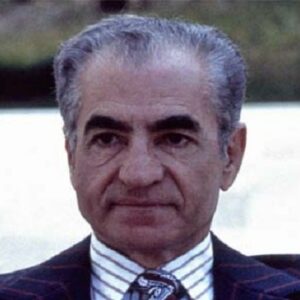Mohammad Reza Shah Pahlavi was Iran’s last Shah, reigning from 1941 to 1979 and enacting numerous changes to promote the country’s economic development. He was the eldest son of his father’s 11 children, and when his father established the Pahlavi dynasty in Iran, he was proclaimed the crown prince. He was anointed Shah of Iran at the age of 20 during World War II, amidst international political turmoil. He pursued a pro-Western foreign policy and promote economic development in Iran during his rule. To modernize the country, he launched a ‘White Revolution,’ in which he dispersed vast land holdings from the wealthiest to four million small-holder farmers. He also supported the establishment of new schools and adult literacy programs in rural areas, as well as the ability to vote for women. In the cities, he supported new manufacturing companies and universities. Corruption in the government and political unrest sparked a revolution that sent him into exile and led Iran to declare itself an Islamic republic. He came to power in the midst of World War II’s chaos, and his reign ended in a similar uproar. He was Iran’s final Shah, bringing the country’s 2,500-year monarchy to an end.
Childhood and Adolescence
On October 26, 1919, he and his twin sister, Ashraf, were born to Reza Pahlavi and his second wife, Tadj of-Molouk. He was the eldest son of the father’s eleven children from four women, and he was the third kid.
When he was five years old, his father, with the help of the British, destroyed the Qajar Dynasty, formed the Pahlavi Dynasty, and became the Shah of Iran. He was proclaimed crown prince upon his father’s coronation in April 1926.
In 1931, he enrolled in Switzerland’s ‘Institut Le Rosey,’ becoming the first Iranian heir apparent to study abroad. He graduated from an Iranian high school in 1936 and spent the next two years in the Tehran Military Academy.
The Career of Mohammad
After a brief struggle, his father was forced to relinquish the throne by British and Russian forces who had conquered the nation, and he was installed as the new Shah of Iran in the fall of 1941.
When World War II concluded in 1945, the United States and the United Kingdom withdrew from their respective realms, but the Soviets refused. His government was able to persuade the Soviet Union to withdraw from northern Iran with the assistance of the United States.
Later, he began the ‘White Revolution,’ in which he nationalized forests and water, established profit-sharing schemes for employees, emancipated women, and organized literacy, sanitation, and development corps with the help of the United States.
Gradually, he became more dictatorial, to the point where he outlawed all political parties save his own Rastakhiz Party, effectively destroying the multi-party system. His opponents, dissatisfied with his leadership, began holding strikes and street protests, to which he responded by deploying the army on Tehran’s streets.
On September 8, 1978, his troops opened fire on a religious dissidents’ demonstration, killing a large number of people. This event, dubbed “Black Friday,” proved to be the beginning of his downfall as a monarch.
Ayatollah Ruhollah Khomenei led a revolution in 1979 that forced him and his family to flee Iran. Within the first six months of his exile, his family traveled to Morocco, the Bahamas, and Mexico.
He grew ill afterward and was granted permission to seek medical care in the United States, where he stayed for a while before returning to Egypt.
Mohammad’s Major Projects
He proposed the ‘White Revolution,’ a national development program that included expanding the road, rail, and air networks, encouraging and supporting industrial expansion, and land reforms.
For the distant rural population, he also organized literacy and health corps. He worked to construct a more autonomous foreign policy in the 1960s and 1970s, establishing working partnerships with the Soviet Union and eastern European countries.
Achievements & Awards
He received the ‘Grand Collar of the Order of the Yoke and Arrows of Spain’ in 1957. He was awarded the ‘Grand Cross with Collar of the Order of Merit of the Republic of Italy’ in the same year.
He was knighted in 1959 and given the title of ‘Order of the Elephant of Denmark.’ He was also awarded the ‘Grand Cross of the Order of the Netherlands Lion in the same year.
He was awarded the “Grand Cross of the Order of the Redeemer of Greece” in 1960, as well as the “Grand Cordon of the Order of Leopold of Belgium.”
He received the ‘Grand Collar of the Order of the Southern Cross of Brazil’ in 1965.
Hungary awarded him the ‘Order of the Flag with Diamonds’ and the ‘Grand Cordon of the Grand Star of Yugoslavia’ in 1966.
Personal History and Legacy
He married Dilawar Princess Fawzia of Egypt, the daughter of Egypt’s King Fuad I, in 1939. Princess Shahnaz Pahlavi was their only child, however, the couple later divorced.
Soraya Esfandiary-Bakhtiari, a half-German, half-Iranian woman, married him for the second time in 1951. He divorced her once it became clear that she couldn’t bear children even with the help of medical specialists.
Then he married Farah Diba, and they had four children: Prince Reza Pahlavi and Prince Ali-Reza Pahlavi, two sons, and Princess Farahnaz Pahlavi and Princess Leila Pahlavi, two girls.
He was diagnosed with non-Hodgkin lymphoma, a kind of blood cancer, in March 1980 and had treatment in Cairo. He died on July 27, 1980, at the age of 60, and was laid to rest in Cairo’s Al Rifa’i Mosque.
Estimated Net worth
Mohammad is one of the wealthiest world leaders and one of the most popular. Mohammad Reza Pahlavi’s net worth is estimated to be $150 million.


